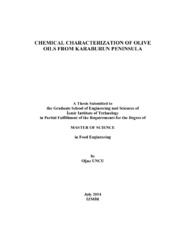Please use this identifier to cite or link to this item:
https://hdl.handle.net/11147/4235Full metadata record
| DC Field | Value | Language |
|---|---|---|
| dc.contributor.advisor | Özen, Fatma Banu | - |
| dc.contributor.author | Uncu, Oğuz | - |
| dc.date.accessioned | 2014-12-04T14:01:08Z | - |
| dc.date.available | 2014-12-04T14:01:08Z | - |
| dc.date.issued | 2014-07 | - |
| dc.identifier.uri | http://hdl.handle.net/11147/4235 | - |
| dc.description | Thesis (Master)--Izmir Institute of Technology, Food Engineering, Izmir, 2014 | en_US |
| dc.description | Includes bibliographical references (leaves: 96-108) | en_US |
| dc.description | Text in English; Abstract: Turkish and English | en_US |
| dc.description | Full text release delayed at author's request until 2017.08.06 | en_US |
| dc.description.abstract | Chemical characteristics of olive oils produced from Erkence olive variety that is mainly grown around Karaburun Peninsula of İzmir have not been investigated thoroughly although this variety has high oil content and ripens earlier compared to other olive types. Identifying the chemical characteristics of olive oils could be useful to obtain geographical indication labelling for olive oils produced from this variety. Aim of this study is to determine some important chemical characteristics of olive oils from Erkence olive variety produced in Karaburun region and to investigate the differences in olive oils that come from various parts of the Peninsula using chemometric techniques as principal component analysis (PCA) and partial least square (PLS) regression. For this purpose, total phenolic content, fatty acid profile, phenolic profile, total carotene and chlorophyll contents and oxidative stability of 64 olive oils were determined. FTIR spectra for these oils were also evaluated. According to PCA results, classification with respect to geographical origin was relatively more successful with FTIR analysis while phenolic and fatty acid profiles did not result very satisfactory separation between regions. Moreover, FTIR spectra and various chemical parameters were used to predict oxidative stability of all olive oil samples. Oxidative stability was predicted successfully from IR spectra whereas prediction from chemical parameters was not that successful. IR spectra were also used to predict various chemical parameters. As a result of PLS regression; chlorophyll and carotenoid, some individual phenolic components (pcoumaric, hydroxtyrosol) and some major fatty acids (oleic, linoleic and palmitic) were predicted. | en_US |
| dc.language.iso | en | en_US |
| dc.publisher | Izmir Institute of Technology | en_US |
| dc.rights | info:eu-repo/semantics/openAccess | en_US |
| dc.subject | Food chemistry | en_US |
| dc.subject | Olive oil | en_US |
| dc.subject | Chemical composition | en_US |
| dc.subject | Chemical characterization | en_US |
| dc.subject | Chemometrics | en_US |
| dc.title | Chemical characterization of olive oils from Karaburun Peninsula | en_US |
| dc.title.alternative | Karaburun Yarımadası zeytinyağlarının kimyasal karakterizasyonu | en_US |
| dc.type | Master Thesis | en_US |
| dc.institutionauthor | Uncu, Oğuz | - |
| dc.department | Thesis (Master)--İzmir Institute of Technology, Food Engineering | en_US |
| dc.relation.publicationcategory | Tez | en_US |
| item.grantfulltext | open | - |
| item.openairecristype | http://purl.org/coar/resource_type/c_18cf | - |
| item.cerifentitytype | Publications | - |
| item.openairetype | Master Thesis | - |
| item.languageiso639-1 | en | - |
| item.fulltext | With Fulltext | - |
| crisitem.author.dept | 01. Izmir Institute of Technology | - |
| Appears in Collections: | Master Degree / Yüksek Lisans Tezleri | |
Files in This Item:
| File | Description | Size | Format | |
|---|---|---|---|---|
| 10013508.pdf | MasterThesis | 2.23 MB | Adobe PDF |  View/Open |
CORE Recommender
Page view(s)
108
checked on Apr 22, 2024
Download(s)
68
checked on Apr 22, 2024
Google ScholarTM
Check
Items in GCRIS Repository are protected by copyright, with all rights reserved, unless otherwise indicated.